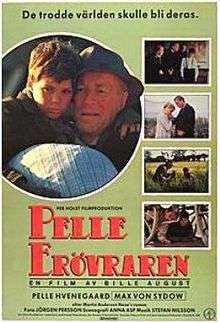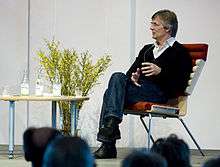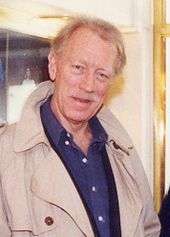Pelle the Conqueror
| Pelle the Conqueror | |
|---|---|
 Original Swedish poster | |
| Directed by | Bille August |
| Produced by | Per Holst |
| Screenplay by |
Bille August Per Olov Enquist Bjarne Reuter Max Lundgren |
| Based on |
Pelle Erobreren by Martin Andersen Nexø |
| Starring |
Max von Sydow Pelle Hvenegaard Erik Paaske Bjørn Granath |
| Music by | Stefan Nilsson |
| Cinematography | Jörgen Persson |
| Edited by | Janus Billeskov Jansen |
Production company | |
| Distributed by |
Svensk Filmindustri (Sweden) Kærne Film (Denmark) |
Release dates |
|
Running time | 150 minutes[1] |
| Country |
Denmark Sweden[2] |
| Language |
Scanian Danish Swedish |
| Budget | $4.5 million[3] |
| Box office | $2,053,931[4] |
Pelle the Conqueror (Danish: Pelle Erobreren, Swedish: Pelle erövraren) is a 1987 Danish-Swedish drama film co-written and directed by Bille August, based upon the famous 1910 novel of the same name by Danish writer Martin Andersen Nexø. The film was critically acclaimed, winning the Palme d'Or at the 1988 Cannes Film Festival, the 1988 Academy Award for Best Foreign Language Film and numerous other awards.
The film tells the story of two Swedish immigrants to Denmark, a father and son, who try to build a new life for themselves. It stars Pelle Hvenegaard as the young Pelle, with Max von Sydow as his father, and also features Axel Strøbye and Astrid Villaume.
Plot
In the late 1850s, the elderly emigrant Lasse Karlsson and his son Pelle arrive to the Danish island of Bornholm from Skåne County, in southern Sweden. Lasse tells Pelle a better life awaits them in Denmark after the death of Pelle's mother, and seeks work. He immediately finds it difficult to find employment, given his advanced age and Pelle's youth. The most they can find is work at a large farm, where they are generally mistreated by the managers. The managers work under the tyrannical Kongstrup, who has a history of affairs leading to illegitimate children. One of them is Rud, who befriends Pelle and helps him learn Danish. Eventually, Pelle becomes more confident in his work at the farm, and begins going to school, though he is still discriminated against as a foreigner. Pelle also befriends the Swedish worker Erik, constantly harassed for alleged sloth. Erik shares his dream of visiting America, China and "Negroland" with Pelle, to "conquer" the world.
Lasse begins an affair with Mrs. Olsen, who is believed to be a widow since her husband has not returned from a long sea voyage. Pelle consequently faces ridicule at school for being the son of a lecher. Erik is also injured and rendered disabled after attempting to lead a mutiny against management. Mrs. Olsen's husband returns from his voyage, and Lasse is overcome with depression and alcoholism. The two appeal to the Kongstrups for aid against their harassment, with the benign Mrs. Kongstrup offering support, while her husband, who she has castrated for his abuse, is largely silent. Pelle is initially given a promotion, but upon seeing Erik removed from the farm, vows to leave. Lasse at first resolves to go with him, before deciding he is too old to travel, and sends Pelle alone into the world.
Cast
- Max von Sydow as Lassefar "Lasse" Karlsson
- Pelle Hvenegaard as Pelle Karlsson
- Erik Paaske as Foreman
- Björn Granath as Erik
- Astrid Villaume as Mrs. Kongstrup
- Axel Strøbye as Kongstrup
- Troels Asmussen as Rud
- Kristina Törnqvist as Anna
- Karen Wegener as Mrs. Olsen
- Sofie Gråbøl as Miss Sine
- Lars Simonsen as Niels Køller
- Buster Larsen as Ole Køller
- John Wittig as Schoolteacher
- Troels Munk as Doctor
- Nis Bank-Mikkelsen as Clergyman
- Lena Pia Bernhardsson as The Sow
- Anna Lise Hirsch Bjerrum as Karna
- Thure Lindhardt as Nilen
Production
Development

The film, based on the 1910 novel of the same name by Martin Andersen Nexø, was co-production by Danish and Swedish companies. With the story involving Danish and Swedish elements, cooperation between producers in both countries had practical benefit.[5]
The screenplay, by director Bille August, Per Olov Enquist, Max Lundgren, and Bjarne Reuter, adapted only the Boyhood part of Nexø's four-volume work.[6] August decided to film the novel because it is considered essential reading in Denmark, and out of desire to make an epic film.[3]
For the title role, Pelle Hvenegaard, who was 11, was cast after August and the crew auditioned 3,000 children. August ruled out hundreds of the children for having ambitious mothers, and decided on Hvenegaard, who he said demonstrated concentration, patience and self-control.[3] He was coincidentally named after the character in Nexø's book.[7]
Filming
The film marked the first collaboration between production designer Anna Asp, who had previously worked on Offret (1986), and August, who had attended a Stockholm school of photography with her.[8] Asp said that in designing the house seen in Pelle the Conqueror, she wanted to evoke a prison, and thus built the walls and painted them black and white.[9]
Filming took place for nearly six months. Its budget of $4.5 million, secured from the Danish and Swedish film institutes, made it one of the most costly films made in the Scandinavian countries.[3]
Release
The film was screened in the Cannes Film Festival in May 1988, and subsequently at the New York Film Festival in September 1988.[10] The film's awards attracted the attention of foreign distributors, with Miramax releasing it in the United States.[11]
Buoyed by the Academy Award recognition,[11] Pelle the Conqueror grossed $2,053,931 in North America,[4] a "respectable" figure for a foreign film.[11] The film had a re-release at Golden West College in Los Angeles in March 1993.[12]
Reception
Critical reception

Pelle the Conqueror was released to critical acclaim in the U.S.[11] Roger Ebert gave it three and a half stars, comparing it to Jan Troell's The Emigrants (1971), saying Max von Sydow's Oscar nomination was "well deserved" and the novice Pelle Hvenegaard "never steps wrong."[7] Vincent Canby, writing for The New York Times, called it "a vividly re-created, minutely detailed panorama of a particular time," and said it was a "scandal" that Von Sydow did not win Best Actor at Cannes.[10] Peter Travers, writing for People, said that Von Sydow exhibited "wrenching simplicity and power," but the film "is maddeningly mediocre."[13]
Mark Chalon Smith, writing in The Los Angeles Times in 1993, praised the film as faithful to the novel and said "Cinematographer Jorgen Persson ... captures several memorable images of the starkly beautiful Danish terrain."[12] Time Out wrote "Despite occasional lapses into sentimentality, the film is saved by its performances and its uncluttered depiction of harsh impoverished lives," particularly praising Van Sydow.[14] In 2004, The New York Times placed the film on its list of "the Best 1,000 Movies Ever Made."[15] Sarah Lutton, writing for the British Film Institute, named Pelle the Conqueror one of "10 great Danish films" and called Van Sydow "extraordinary."[16] Van Sydow later also called it "a very beautiful film."[17] The film holds a 100% rating on Rotten Tomatoes.[18]
Accolades
Pelle the Conqueror won the Palme d'Or at the 1988 Cannes Film Festival[19] The film also won the Academy Award for Best Foreign Language Film, 1988;[20] it was submitted to the Academy by the Danish government, giving Denmark its second consecutive win after Babette's Feast.[21] The Oscars ceremony also marked Max von Sydow's first nomination for the Academy Award for Best Actor.[22]
See also
- List of submissions to the 61st Academy Awards for Best Foreign Language Film
- List of Danish submissions for the Academy Award for Best Foreign Language Film
References
- ↑ "PELLE THE CONQUEROR (12)". British Board of Film Classification. 1988-12-07. Retrieved 2013-03-06.
- ↑ http://ftvdb.bfi.org.uk/sift/title/311517
- 1 2 3 4 Russell, Candice (19 March 1989). "Great Expectations At Heart Of Oscar-nominated Film". Sun-Sentinel. Retrieved 5 September 2016.
- 1 2 "Pelle the Conqueror". Box Office Mojo. Retrieved 5 September 2016.
- ↑ Nataša Durovicová and Kathleen E. Newman, World Cinemas, Transnational Perspectives, Routledge, 2010, p. 16.
- ↑ Dowd, A.A. (15 August 2013). "Pelle The Conqueror conquered at Cannes—and at the Oscars and Golden Globes". The A.V. Club. Retrieved 5 September 2016.
- 1 2 Ebert, Roger (3 March 1989). "Pelle the Conqueror". Rogerebert.com. Retrieved 5 September 2016.
- ↑ Peter Ettedgui, Production Design & Art Direction, Focal Press, 1999, p. 109.
- ↑ Ettedgui, p. 114.
- 1 2 Canby, Vincent (30 September 1988). "Film Festival; Von Sydow as a Father In 'Pelle the Conqueror'". The New York Times. Retrieved 5 September 2016.
- 1 2 3 4 Andrew K. Nestingen and Trevor Glen Elkington, Transnational Cinema in a Global North: Nordic Cinema in Transition, Wayne State University Press, 2005, p. 36.
- 1 2 Smith, Mark Chalon (11 March 1993). "Humor and Dignity Ease Pain of 'Pelle'". The Los Angeles Times. Retrieved 5 September 2016.
- ↑ Travers, Peter (January 16, 1989). "Picks and Pans Review: Pelle the Conqueror". People, Vol. 31 No. 2. Retrieved 5 September 2016.
- ↑ CM. "Pelle the Conqueror". Time Out. Retrieved 5 September 2016.
- ↑ "The Best 1,000 Movies Ever Made". The New York Times. 2004. Retrieved 5 September 2016.
- ↑ Lutton, Sarah (14 July 2016). "10 great Danish films". British Film Institute. Retrieved 5 September 2016.
- ↑ Smith, Krista (February 2012). "Max von Sydow on Extremely Loud and Incredibly Close and His Secret Dream Project". Vanity Fair. Retrieved 5 September 2016.
- ↑ Pelle the Conqueror at Rotten Tomatoes
- 1 2 "Festival de Cannes: Pelle the Conqueror". festival-cannes.com. Retrieved 2009-07-27.
- 1 2 "The 61st Academy Awards (1989) Nominees and Winners". oscars.org. Retrieved 20 August 2015.
- ↑ Mette Hjort and Duncan J. Petrie, eds., The Cinema of Small Nations, Edinburgh University Press, 2007, p. 23.
- ↑ Hammond, Pete (8 December 2011). "OSCARS: Stellar Work By Veterans May Keep Upstarts Out Of Supporting Actor Race". Deadline.com. Retrieved 5 September 2016.
- ↑ "Film Not in the English Language in 1990". British Academy of Film and Television Arts. Retrieved 5 September 2016.
- ↑ "1988 Årets vindere". Bodil Prisen. Retrieved 6 September 2016.
- ↑ "PELLE LE CONQUÉRANT". AlloCiné. Retrieved 5 September 2016.
- ↑ "European Film Awards 1988". European Film Academy. Retrieved 5 September 2016.
- ↑ "Pelle The Conqueror". Golden Globe Awards. Retrieved 5 September 2016.
- ↑ "Pelle Erobreren (1987)". Swedish Film Institute. 15 March 2014.
- ↑ "1988 Award Winners". National Board of Review. Retrieved 5 September 2016.
- ↑ "Tenth Annual Youth in Film Awards 1987-1988". Young Artist Awards. Retrieved 5 September 2016.
External links
- Pelle the Conqueror at the Internet Movie Database
- Pelle the Conqueror in the Danish National Filmography
- Pelle Erobreren at the Swedish Film Institute Database

- Pelle the Conqueror at Box Office Mojo
- Pelle the Conqueror at Rotten Tomatoes
- Pelle the Conqueror at Project Gutenberg
- Moviekids.org